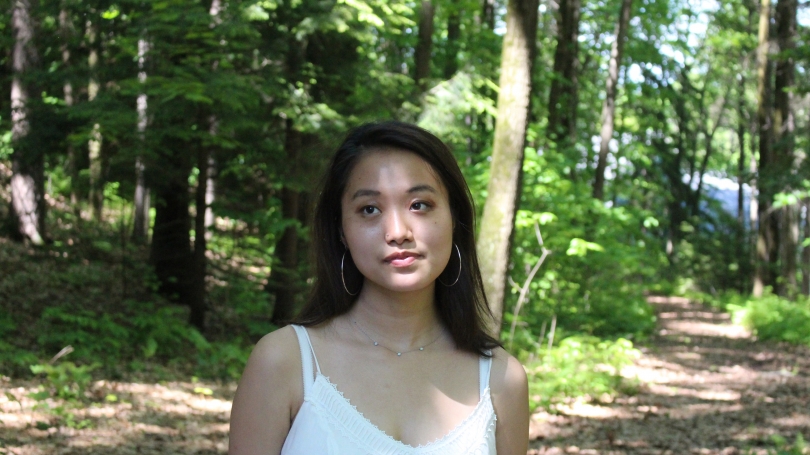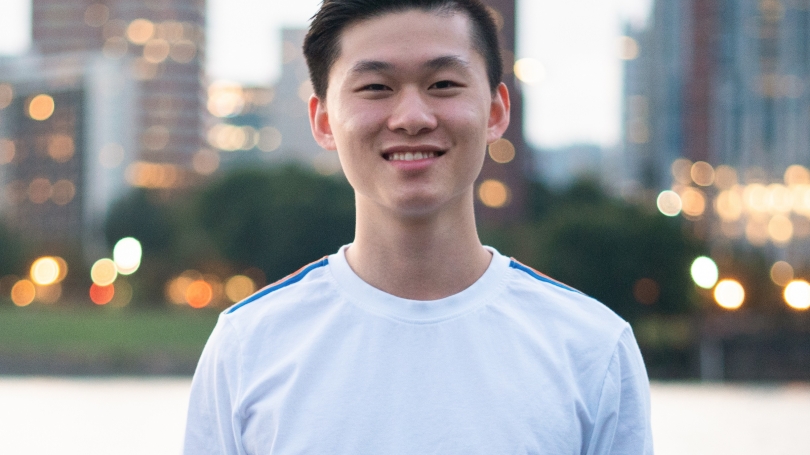In Their Own Words: The DSO Soloists and Their Music
As they prepare to play challenging and delicious solos with the Dartmouth Symphony Orchestra on October 5, Dartmouth seniors Alyssa Gao, Betty Kim and Richard Lu share what they love about the concertos they will perform.
Over the past week or so, I had the opportunity to sit down and chat individually with each of the three soloists who will be soloists with the Dartmouth Symphony Orchestra on Saturday, October 5 — Alyssa Gao '20, who will be performing Tchaikovsky's Violin Concerto, Betty Kim '20, who will be performing Ravel's Tzigane on the violin, and Richard Lu '20, who'll be performing Tchaikovsky's Rococo Variations on the cello. Each conversation revealed not only the musician's connection to his or her piece, but also a sense of music as language — which can express what could never be said in one conversation or a hundred.
Playing the longest of the three pieces, Alyssa Gao will perform first, to be followed by a brief intermission and then Kim and Lu. For approximately 40 minutes, Gao will command the room. For all this, Gao comes off as remarkably self-assured, not even feeling the need to bring the length of the Violin Concerto up until I specifically asked her about it. She describes the piece as "romantic" and "dramatic," with greater speed at the beginning and end than in the middle. (Smiling with fondness for the piece, she refers to the middle, or the second of three "movements," as "sweet rather than wild, like a little break.") Tchaikovsky, she notes, employs a lot of repetition and the modulation of previously used themes, which tends to have the effect of telling a story: places, plots, and characters often recur, but they change as you flip the pages of the book (or the music).
The concerto is one of her favorite musical pieces, Gao explains, because "Tchaikovsky employs a wide and diverse range of colors and emotions," and as a non-musician, I can't resist asking her about that. What does it mean for music to have color? She pauses, and then says that it's not "black and white" like some concertos are — it's not simply here or there in your ear, making this sound or that sound. When the recurring theme appears for the first time in the concerto, it sounds warm and intimate, like the soothing orange of a sunset. By contrast, in its second appearance, the theme moves higher up on the violin: it is played with the two highest strings, and the addition of chords. At this higher pitch, Gao sees (or hears?) the sound as more of a bright yellow, with the theme and other notes bouncing through the colors of the rainbow as the concerto progresses. The romantic love that we hear in these notes and colors, she adds, is far from imagined: Tchaikovsky is said to have had romantic feelings for the violinist with whom this piece was initially composed, giving the piece an organic quality that not all concertos have.
Gao's own love affair with the piece goes back a long way. She learned the second and third movements of the concerto in her senior year of high school, performing it with piano accompaniment rather than orchestra. When she arrived at Dartmouth for her freshman fall, she committed herself to learning the first movement, and actually auditioned for and scheduled this upcoming performance with the DSO during her freshman spring — roughly two and a half years ago! Though she's had the piece in her mind for a while, she's excited to finally perform it with an orchestra. With palpable eagerness in her voice, she explains that while playing alongside the piano is "more intimate," an orchestra has the advantage of "so many different moving parts." Moreover, this (playing with an orchestra) is what the piece was written for: an orchestra can "express more musical variation than a single piano can, and it's more challenging for the soloist than performing with a pianist is." When an entire orchestra is there to accompany you, Gao tells me, your job is more than just to play music — you have to lead. "You have to stand out," she says, blushing but not flinching at the prospect. With her keen grasp of the piece and genuine love of its lyricism, there's no doubt that she will.
After the intermission, the audience will be greeted with a radically different piece — Ravel's Tzigane, played by Betty Kim. When we meet, one of the first things that Betty tells me is that her piece diverges from "the typical concerto," which she describes as a progression "from fast, to slow, and then to really fast." Hers, on the other hand, is infused with an "Impressionist energy," which is enriched all the more by the inspiration that Ravel took from the East. As a result, "the structure of the piece is free-flowing… It basically sounds unstructured to a Western ear." Compared to the other two, it's a relatively non-traditional piece, making it much less commonly performed. Audience members are unlikely to hear it outside of Saturday's concert. It is also extraordinarily technically demanding, comprising about ten intense minutes — and for the first five of these, Kim will be playing alone, unaccompanied by the orchestra. This type of solo-within-a-solo is known as a "cadenza," and Kim compares this nerve-wracking segment to when a singer comes onstage with no works behind her — no backup singers, no smoke, and no instruments. That sense of appearing with "just your voice" (or in this case, just your violin) influences Kim's approach to the cadenza, which she describes as being a bit like a TED talk in its isolation. It is, she declares with conviction, like "baring your soul through performance."
How do you muster up the courage to do that for five minutes straight in a room chock-full of classical music enthusiasts? If you're like Kim, such confidence develops over time. In that way, "it's more of a theatrical performance than a musical performance," she tells me. "You have to be taken seriously." When she's onstage, Kim allows the music to speak through her. She remains ever-conscious of the difference between "the notes on the page versus the notes that come out," and doesn't necessarily privilege one above the other. In fact, she informs me that once upon a time (such as during the Baroque period), classical music was improvised somewhat — and when I respond with shock, saying that I never would have guessed that what with our modern understanding of classical music (which I, like a child, still perceive as a little "formal"), she nods in commiseration. "But that's what so great about this piece," she adds. "The tempo's not fixed. Unlike many concertos, it doesn't sound as though it's broken into separate parts."
Most interestingly of all, Kim explains that there is a constant give-and-take between the soloist and the orchestra throughout this piece (after the cadenza), with the soloist and the orchestra having to remain hyper-aware of each other's shifts in tempo. "Nothing guarantees that the orchestra will know exactly what you're feeling at a given moment, and how fast you'll want to go," she says, adding that because she spends much of the piece playing about twice as fast as however fast the orchestra goes, there's always a concern that they'll go too fast for her to double it. "Still," she remarks, "I do take pride in the fact that I've usually been the one pushing them to go faster in rehearsals." In addition to the technical demands of this close collaboration, the piece challenges the soloist through its use of "extended technique" — wherein Kim sometimes has to pluck the strings with her left hand instead of just using the bow, and bounce the bow across the strings instead of just playing separate notes. Reflecting on the challenges presented by this piece, Kim tells me that she played it during her senior year of high school, but that it was very difficult for her and she really didn't have a good time doing it. Her long practices at that time felt almost self-punitive, and she wanted to use this solo with the DSO as a chance to have more fun with the music. "I wanted to play it and actually enjoy it," she says. Approaching her performances with less fear now, and learning not to take every mistake so seriously, has helped to grow as a musician. Personally as well as musically, her performance will be a triumph.
Richard Lu, who'll be playing Tchaikovsky's Rococo Variations on the cello, is every bit as personally connected to his solo as the other two soloists are. Unsurprisingly, it is one of his favorite pieces for the cello. Like the other two soloists, he began learning his piece in high school (in the ninth grade, to be precise), but had to stop playing it after developing tendonitis in both wrists. Over the past several years, he's taken several breaks from the cello to recover from tendonitis, but has found that he can never stay away from the instrument for very long — often falling into a cycle of playing intensely for a few weeks and then, only once it's unbearable, taking a break. When I ask him why he persists with the cello despite these difficulties, he replies that the cello simply "registers" with him. Although he started playing the piano when he was five years old, he wanted to "try something different" by the time that he was eight, and settled on the cello because it's a string instrument and he felt drawn to its deep sound.
One advantage to the uphill battle of fighting tendonitis, however, is that the frequent breaks and returns to the cello give him renewed perspectives on the music. Since this wasn't a completely new piece to Lu when he began rehearsing for this solo, he found it interesting to return to the piece with "improved skills" — a common theme noted by all three of the soloists about their pieces. "It sounds better than it did when I was in high school, honestly," Lu says with a laugh. "And that's a good thing." Lu notes that the piece is challenging in part because it packs a huge array of emotions into only 15 to 20 minutes with no real "pauses" in between. You have to capture those emotions, he explains, without neglecting the technical demands of the music. While Lu's favorite of the seven variations is the sixth one, which is characterized by a quiet melancholy that "perfectly sets up the piece's final variation and coda," it might interest to audiences to know that this would not have been the sixth variation in Tchaikovsky's original composition. "People scrambled the order of the variations," Lu remarks, adding that one of those scrambles eventually became the dominant one that most performers (including him) now employ. After all, "it's the order that works."
Lu unknowingly sums up the mood of all three soloists when he says, "Soloing with an orchestra is one of the best things that a classical musician can do. It's so motivating." His eagerness to perform is matched by both Kim's and Gao's, giving Dartmouth students and Hanover residents alike the most that they could ask for — exceptionally talented, driven musicians who've been working on these solos for years, and who now can't wait to perform for them. The concert promises to be a tour de force of both musical beauty and human tenacity.


